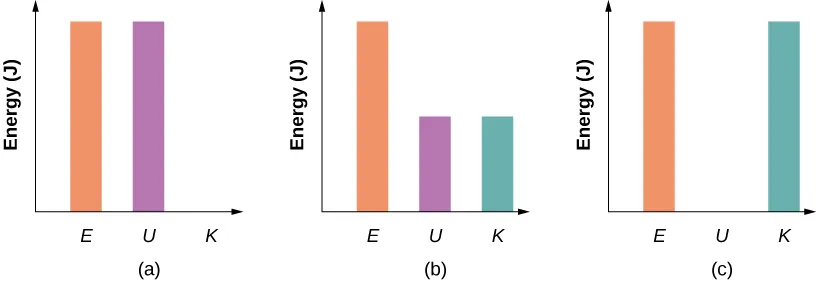OCR Specification focus:
‘State the principle of conservation of energy and apply it to closed systems quantitatively.’
The principle of conservation of energy is fundamental in physics, describing how energy cannot be created or destroyed, only transformed or transferred within and between systems.
The Principle of Conservation of Energy
The principle of conservation of energy is one of the most important and universal laws in physics. It underpins the analysis of all mechanical, electrical, and thermal systems. According to this principle, the total energy in a closed system remains constant, even though energy may change form or move between objects within that system.
Conservation of Energy: In a closed system, energy cannot be created or destroyed; it can only be transferred or converted from one form to another.
This principle allows physicists to analyse systems quantitatively by tracking energy changes between different forms such as kinetic, potential, thermal, electrical, or chemical energy. The total energy before and after a process must be the same.
Closed and Open Systems
The conservation principle strictly applies to closed systems, where no energy enters or leaves the boundaries of the system.
In a closed system, all energy transfers occur internally, and total energy remains constant.
In an open system, energy can cross the system boundary—for example, heat entering or leaving, or work being done by an external force.
In real-life situations, few systems are perfectly closed, but many can be approximated as such for analysis if energy losses (for example, due to friction or air resistance) are small.
Quantitative Application of Energy Conservation
The conservation of energy can be expressed quantitatively by an energy balance equation. For any process within a closed system:
EQUATION
—-----------------------------------------------------------------
Total Energy Before = Total Energy After
or
Σ Energy_initial = Σ Energy_final
—-----------------------------------------------------------------
This simple expression provides the foundation for calculating energy changes in mechanical systems, such as objects in motion or under the influence of gravity.

Energy bar charts for a pendulum at three positions: all PE at the top, mixed mid-swing, and all KE at the bottom. The total energy bar remains constant, illustrating conservation within a closed system. Source.
To apply the principle quantitatively:
Identify all forms of energy present before and after the process.
Set the total initial energy equal to the total final energy.
Solve for unknown quantities such as speed, height, or energy lost to the surroundings.
Forms of Energy in Mechanical Systems
The two most common energy forms considered in mechanical systems are kinetic energy and gravitational potential energy.
Kinetic energy (Ek): the energy an object has due to its motion.
Gravitational potential energy (Ep): the energy stored due to an object’s position in a gravitational field.
EQUATION
—-----------------------------------------------------------------
Kinetic Energy (Ek) = ½mv²
m = mass (kg)
v = velocity (m s⁻¹)
—-----------------------------------------------------------------
EQUATION
—-----------------------------------------------------------------
Gravitational Potential Energy (Ep) = mgh
m = mass (kg)
g = gravitational field strength (N kg⁻¹)
h = height above a chosen reference level (m)
—-----------------------------------------------------------------
In a closed system, any decrease in Ep corresponds to an increase in Ek, provided that no external work is done and energy losses (such as frictional heating) are negligible.

A simple pendulum illustrating conservation of mechanical energy: PE is greatest at the extremes, while KE is greatest at the lowest point. Total energy remains constant throughout the motion. Source.
Energy Transfers and Transformations
The conservation of energy principle allows tracking energy pathways between stores:
Mechanically, through forces doing work (e.g. a spring pushing an object).
Electrically, through current transferring energy (e.g. a motor converting electrical energy to kinetic).
Thermally, through heating (e.g. conduction or radiation).
By radiation, such as light or sound waves transferring energy across space.
In all cases, the total amount of energy remains constant; only the form or location of the energy changes.
Internal Energy and Energy Dissipation
In many real systems, some mechanical energy appears to be “lost.” However, energy is never destroyed; it is simply transferred to less useful forms, usually thermal energy due to friction or resistance. This increases the internal energy of the objects or surroundings.
Internal Energy: The total energy contained within a system due to the kinetic and potential energies of its particles.
Though the total energy is still conserved, energy dissipated as heat or sound is usually spread out and harder to recover, making the process less efficient.
Conservation of Energy in Problem Solving
When solving energy problems using the conservation principle, physicists typically:
Identify the system and its boundaries.
Choose a suitable reference level for potential energy.
Write expressions for all relevant energy forms.
Apply the energy conservation equation to relate them.
Ignore or include losses depending on whether the system is assumed to be ideal or real.
This systematic approach simplifies analysis across many branches of physics—from mechanics and thermodynamics to electricity and nuclear processes.
Broader Applications of Energy Conservation
The conservation of energy applies universally:
In mechanics, it predicts motion in pendulums, projectiles, and roller coasters.
In electrical circuits, it governs power and energy transfer between components.
In thermodynamics, it underpins the first law of thermodynamics, stating that the change in internal energy equals the heat added minus the work done.
In nuclear and particle physics, mass and energy equivalence (E = mc²) extends the conservation law to include mass-energy transformations.
Each of these applications reflects the same unchanging truth: the total energy of the universe is constant, even as energy continually flows and transforms between systems and forms.

A roller coaster illustrating how gravitational potential energy converts to kinetic energy and back along the ride. At high points PE is large and KE small; at low points KE is large and PE small, while total energy remains constant. Source.
FAQ
Conservation of energy refers to the total energy in a closed system remaining constant, even as it changes form. Energy can be transferred between kinetic, potential, thermal, and other types, but the total sum does not change.
Conservation of momentum, on the other hand, deals with the total momentum of objects before and after an interaction. While both principles apply to closed systems, energy can change type, whereas momentum only changes direction or distribution between objects.
When friction acts, mechanical energy (kinetic and potential) is not conserved because some energy is transformed into thermal energy due to microscopic interactions.
However, the total energy of the system—including this heat—is still conserved.
Mechanical energy decreases.
Internal (thermal) energy increases.
Therefore, the conservation principle still holds if all forms of energy, including heat, are accounted for.
Energy may appear to be lost when it spreads out into less useful forms, such as heat or sound. This process is known as energy dissipation.
In practice, this happens in almost every energy transfer because perfect efficiency is impossible. While the energy remains in the universe, it becomes too dispersed to do useful work—hence why it seems to “disappear.”
Potential energy depends on an object’s position relative to a chosen reference level. Selecting this level ensures energy calculations are consistent and comparisons are meaningful.
If the ground is chosen as the reference, Ep = 0 at that point.
Choosing a different reference (e.g., table height) does not affect energy changes, only the numerical values.
This makes potential energy differences, not absolute values, physically important in applying conservation of energy.
The first law of thermodynamics is a broader expression of energy conservation, applying to systems involving heat and work.
It states:
The change in a system’s internal energy equals the heat added minus the work done by the system.
In essence, it extends the conservation principle beyond mechanical systems, showing that energy is always accounted for, even in thermal and chemical processes.
Practice Questions
Question 1 (2 marks)
State the principle of conservation of energy and explain what this means for a closed system.
Mark Scheme:
1 mark: States that energy cannot be created or destroyed.
1 mark: Explains that in a closed system, the total energy remains constant, though it may change form or be transferred within the system.
Question 2 (5 marks)
A ball of mass 0.50 kg is dropped vertically from rest from a height of 2.0 m above the ground. Assume there is no air resistance.
(a) Calculate the gravitational potential energy of the ball relative to the ground before it is dropped.
(b) Determine the speed of the ball just before it hits the ground.
(c) Explain how your answers illustrate the principle of conservation of energy in a closed system.
Mark Scheme:
(a)
1 mark: Uses Ep = mgh.
1 mark: Correct substitution: Ep = 0.50 × 9.8 × 2.0.
1 mark: Correct answer: Ep = 9.8 J (accept 9.8 or 10 J depending on rounding).
(b)
1 mark: Recognises that gravitational potential energy is converted to kinetic energy, i.e. Ep = Ek.
1 mark: Uses ½mv² = mgh → v = √(2gh).
1 mark: Substitutes correctly and finds v = √(2 × 9.8 × 2.0) = 6.3 m s⁻¹ (accept values between 6.2–6.3 m s⁻¹).
(c)
1 mark: States that total energy remains constant as potential energy is transformed into kinetic energy.
1 mark: Notes that because the system is closed and air resistance is neglected, no energy is lost, demonstrating the conservation of total energy.

